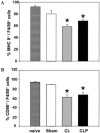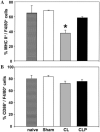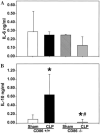Sepsis-induced changes in macrophage co-stimulatory molecule expression: CD86 as a regulator of anti-inflammatory IL-10 response
- PMID: 15744129
- PMCID: PMC2253680
- DOI: 10.1089/sur.2004.5.375
Sepsis-induced changes in macrophage co-stimulatory molecule expression: CD86 as a regulator of anti-inflammatory IL-10 response
Abstract
Background: Sepsis remains a substantial risk after surgery or other trauma. Macrophage dysfunction, as a component of immune suppression seen during trauma and sepsis, appears to be one of the contributing factors to morbidity and mortality. However, whereas it is known that the ability of macrophages to present antigen and express major histocompatibility complex MHC class II molecules is decreased during sepsis, it is not known to what extent this is associated with the loss of co-stimulatory receptor expression. Our objectives in this study were, therefore, to determine if the expression of co-stimulatory molecules, such as CD40, CD80, or CD86, on peritoneal/splenic/liver macrophages were altered by sepsis (cecal ligation [CL] and puncture [CLP] or necrotic tissue injury (CL) alone; and to establish the contribution of such changes to the response to septic challenge using mice that are deficient in these receptors.
Methods: To address our first objective, male C3H/HeN mice were subjected to CLP, CL, or sham (n = four to six mice/group), and the adherent macrophages were isolated from the peritoneum, spleen, or liver at 24 h post-insult. The macrophages were then analyzed by flow cytometry for their ex vivo expression of CD40, CD80, CD86, and/or MHC II.
Results: The expression of CD86 and MHC II, but not CD40 or CD80, were significantly decreased on peritoneal macrophages after the onset of sepsis or CL alone. In addition, CD40 expression was significantly increased in Kupffer cells after sepsis. Alternatively, splenic macrophages from septic or CL mice did not show changes in the expression of CD80, CD86, or CD40. To the degree that the loss of CD86 expression might contribute to the changes reported in macrophage function in septic mice, we subsequently examined the effects of CLP on CD86 -/- mice. Interestingly, we found that, unlike the background controls, neither the serum IL-10 concentrations nor the IL-10 release capacity of peritoneal macrophages from septic CD86 -/- mice were increased.
Conclusion: Together, these data suggest a potential role for the co-stimulatory receptor CD86/B7-2 beyond that of simply promoting competent antigen presentation to T-cells, but also as a regulator of the anti-inflammatory IL-10 response. Such a role may implicate the latter response in the development of sepsis-induced immune dysfunction.
Figures






Similar articles
-
Polymicrobial sepsis induces divergent effects on splenic and peritoneal dendritic cell function in mice.Shock. 2004 Aug;22(2):137-44. doi: 10.1097/01.shk.0000131194.80038.3f. Shock. 2004. PMID: 15257086 Free PMC article.
-
Diversity of interferon gamma and granulocyte-macrophage colony-stimulating factor in restoring immune dysfunction of dendritic cells and macrophages during polymicrobial sepsis.Mol Med. 2008 May-Jun;14(5-6):247-56. doi: 10.2119/2007-00120.Flohe. Mol Med. 2008. PMID: 18297128 Free PMC article.
-
Interferon-gamma and interleukin-10 inhibit antigen presentation by Langerhans cells for T helper type 1 cells by suppressing their CD80 (B7-1) expression.Eur J Immunol. 1996 Mar;26(3):648-52. doi: 10.1002/eji.1830260321. Eur J Immunol. 1996. PMID: 8605933
-
Immune depression in polymicrobial sepsis: the role of necrotic (injured) tissue and endotoxin.Crit Care Med. 2000 Aug;28(8):2949-55. doi: 10.1097/00003246-200008000-00044. Crit Care Med. 2000. PMID: 10966277
-
Regulation of self-tolerance by CD80/CD86 interactions.Curr Opin Immunol. 1997 Dec;9(6):858-62. doi: 10.1016/s0952-7915(97)80190-2. Curr Opin Immunol. 1997. PMID: 9492990 Review.
Cited by
-
Effect of clarithromycin in inflammatory markers of patients with ventilator-associated pneumonia and sepsis caused by Gram-negative bacteria: results from a randomized clinical study.Antimicrob Agents Chemother. 2012 Jul;56(7):3819-25. doi: 10.1128/AAC.05798-11. Epub 2012 May 7. Antimicrob Agents Chemother. 2012. PMID: 22564837 Free PMC article. Clinical Trial.
-
Contribution of programmed cell death receptor (PD)-1 to Kupffer cell dysfunction in murine polymicrobial sepsis.Am J Physiol Gastrointest Liver Physiol. 2016 Aug 1;311(2):G237-45. doi: 10.1152/ajpgi.00371.2015. Epub 2016 Jun 10. Am J Physiol Gastrointest Liver Physiol. 2016. PMID: 27288425 Free PMC article.
-
Modulation of the Bcl-2 family blocks sepsis-induced depletion of dendritic cells and macrophages.Shock. 2009 Apr;31(4):359-66. doi: 10.1097/SHK.0b013e31818ba2a2. Shock. 2009. PMID: 18838943 Free PMC article.
-
Lipopolysaccharide desensitizes monocytes-macrophages to CD40 ligand stimulation.Immunology. 2007 Nov;122(3):362-70. doi: 10.1111/j.1365-2567.2007.02648.x. Epub 2007 Jun 29. Immunology. 2007. PMID: 17608691 Free PMC article.
-
Involvement of TLR2 and TLR4 in cell responses to Rickettsia akari.J Leukoc Biol. 2010 Oct;88(4):675-85. doi: 10.1189/jlb.1009674. Epub 2010 Jul 8. J Leukoc Biol. 2010. PMID: 20616112 Free PMC article.
References
-
- Angus DC, Linde-Zwirble WT, Lidicker J, et al. Epidemiology of severe sepsis in the United States: Analysis of incidence, outcome, and associated costs of care. Crit Care Med. 2001;29:1303–1310. - PubMed
-
- Salomon B, Bluestone JA. Complexities of CD28/B7: CTLA-4 costimulatory pathways in autoimmunity and transplantation. Annu Rev Immunol. 2001;19:225–252. - PubMed
-
- Lanier LL, O’Fallon S, Somoza C, et al. CD80 (B7-1) and CD86 (B7-2) provide similar costimulatory signals for T cell proliferation, cytokine production, and generation of CTL. J Immunol. 1995;154:97–105. - PubMed
Publication types
MeSH terms
Substances
Grants and funding
LinkOut - more resources
Full Text Sources
Medical
Research Materials
Miscellaneous

